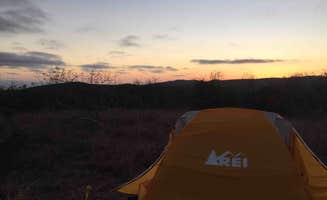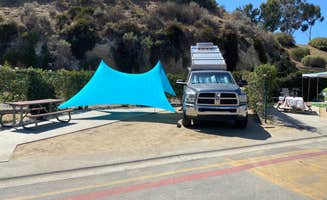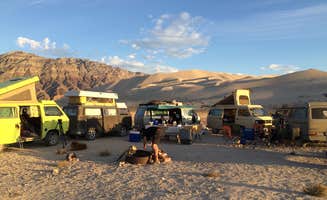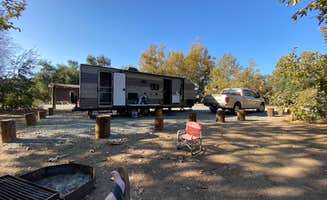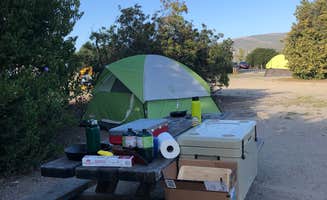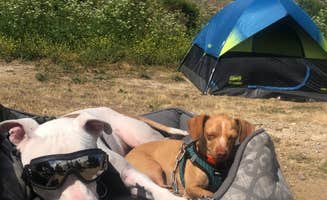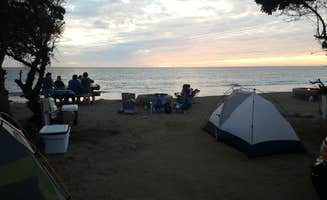Camping spots near Laguna Beach, California sit within a Mediterranean climate zone receiving less than 13 inches of annual rainfall, mostly between November and March. The coastal sage scrub ecosystem surrounding these campgrounds creates distinct vegetation patterns visible from many sites, with summer temperatures averaging 75-85°F during peak camping season. The marine layer often rolls in during mornings before burning off by midday.
What to do
Mountain biking through adjacent wilderness parks: Access extensive trail networks from O'Neill Regional Park, which connects to larger wilderness areas. "The campground is located next to Oneil Park, which is huge and great for bike and running. There are many hiking trails nearby in all directions. I usually ride to Caspers from the campsite or Trabruco creak up to Holy Jim," notes Mike G.
Explore tidepools at low tide: The rocky shoreline near San Clemente State Beach Campground offers exceptional marine life viewing opportunities. "Lots of fun things along the beach to look at like tide pools and rock formations," according to visitors. Plan visits during morning low tides for best viewing conditions.
Visit historic beach cottages: Walk through preserved 1920s-40s structures at Crystal Cove State Park. "We popped in and luckily was able to get the best view in house, please check them out and support the cottages!" writes Kenny T. The cottages showcase early California coastal architecture and can be toured without overnight stays.
What campers like
Terraced campsites with ocean views: Moro Campground at Crystal Cove State Park features elevated sites ensuring visibility. "The sites are terraced, so no matter which site you get you'll have a view of the ocean," explains Elly A. Sites in upper rows still maintain ocean visibility despite being further from the shore.
Wildlife encounters: Morning and evening animal sightings enhance camping experiences. A visitor to Ronald W. Caspers Wilderness Park mentions "Plenty of squirrels, bunnies, the occasional deer and coyotes at night, signs warning you are now in mountain lion territory." The park's inland location increases wildlife viewing opportunities.
Quick escape from urban environments: Despite proximity to development, campgrounds provide natural settings. "ONeil is a great little park that's tucked away among the urban sprawl of Orange County. Once in the park you feel like you're far out in the wilderness," reports Berton M. Most campgrounds are within 30 minutes of urban amenities yet maintain natural surroundings.
What you should know
Reservation requirements and timing: High demand necessitates advance planning. "This campground fills up fast so book early!" warns one camper at Crystal Cove. Sites at popular locations can book 6 months in advance, particularly for summer weekends and holidays.
Noise considerations: Highway and urban sounds affect some campgrounds more than others. At Doheny State Beach Campground, "After traffic noise dies down and in between the trains that rumble by, you can almost hear the ocean at the sites that back to the street," notes Lee D. Consider site location relative to roads and railways.
Fire restrictions vary by location: Rules range from complete prohibition to propane-only. "No coal or wood fires :( Kind of a bummer since your evening ends early. You can bring propane pits yourself for fires though," a Crystal Cove visitor explains. Always verify current fire regulations before arrival.
Wildlife precautions: Several campgrounds report active wildlife. "We had to be careful if you plan to climb down into it," warns Kim L. at Caspers Wilderness Park, while another camper notes: "Be careful of rattlesnakes" at multiple locations.
Tips for camping with families
Playground access and kid-friendly trails: San Mateo Campground at San Onofre State Beach offers facilities specifically designed for children. "Lots of kids riding bikes and having fun! I suggest to follow their lead. Bring a bike to explore the loops and trail to beach," recommends Jeannie B. The 1.5-mile beach trail provides a manageable hike for most children.
Beach activity options: Various water features keep children engaged at different locations. At Newport Dunes RV Resort, they have "activities for the kids like arts and crafts, an inflatable obstacle course or you can rent paddle boards or watch a movie on the beach," reports Karissa J. Check activity schedules when booking.
Consider inland options during peak summer heat: Coastal fog can make mornings chilly while inland areas warm faster. "It can be really hot in late summer early fall," notes Kelly E. about Caspers Wilderness Park. Morning activities at inland sites and afternoon beach time creates optimal temperature conditions.
Story trails for young hikers: Educational paths engage children during walks. "Great and fun 'Story Trail' hike for children. The hike features a new book every month, each page is mounted to a placard along the trail," mentions Johnny G. at O'Neill Regional Park.
Tips from RVers
Site dimensions and backing challenges: Many coastal campgrounds have tight access roads. "The roads that lead to the sites is a bit narrow, so if your towable is on the long side, you might have to work a bit to back it in. The maximum length is 38," warns Patrick J. at Crystal Cove State Park. Measure your rig and verify campground limits before booking.
Electrical requirements and availability: Power options vary significantly between campgrounds. "We stayed in a site with electricity and water. No sewer hook-up but there is a dump station in the campground," notes a camper at Crystal Cove. Some sites offer 50-amp service while others provide only 30-amp or no hookups at all.
Water fill and dump station logistics: Plan for limited hookups at most state beaches. At Doheny State Beach, "RV tank filling also available at the same location of dump site only a few feet away as you drive out. You can screw in your own hose and your good to go," explains Manuel P. Most dump stations charge additional fees ($10 at Doheny).



